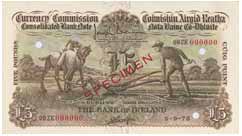
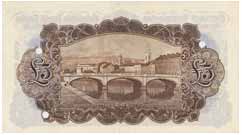
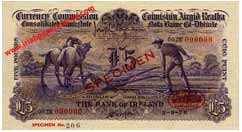
Since its opening to public access in 2017, the Central Bank of Ireland Archive has provided much new source material on the Consolidated Bank Notes. The archive is referenced as CBIAR in the text.
The Ploughman Scan Survey is a detailed recording of the serial numbers and grades of the surviving Ploughman Pound notes. The survey has been underway for over 15 years and has lead to a solid data set of banknotes recorded, currently standing at 3,902, of which 926 are £5 notes. A steady trickle of newly recorded notes are added each month.
Information on the numbers recorded of Ploughman Five Pound notes is updated periodically in the Ploughman Note Population Report.
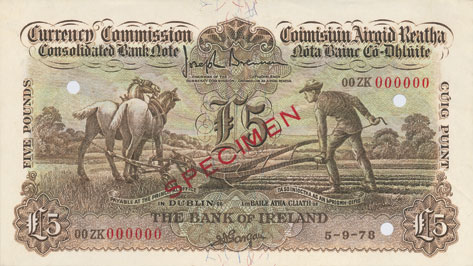
![]()
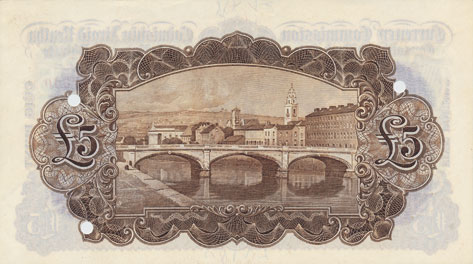
The Ploughman banknotes were designed by artist Dermod O'Brien (1865-1945) [2.].
The Five Pound Consolidated Bank Note is primarily brown in colour, with a yellow and orange underprint. This colour scheme was similar to that of the 'Lady Lavery' series Five Pound Legal Tender Notes which were first issued in 1928, which the Consolidated 5 Pound notes circulated alongside from their first issue in 1929.
All the text on the face of the note is bilingual, being printed in English on the left side and in Irish on the right.
The main title of the Issuing Authority at the top of the banknote is in ornate script: 'Currency Commission Consolidated Bank Note', 'Coimisiún Airgid Reatha Nóta Bainc Có-Dhlúite'.
The main signature, Joseph Brennan [3.], is printed at the top in the centre of the note. His title is below his signature in small letters, 'Chairman of the Currency Commission', 'Cathaoirleach Choimisiúin an Airgid Reatha'.
The denomination in words is printed sideways on either side, 'Five Pounds' on the left, 'Cúig Puint' on the right.
Printed in smaller text at the bottom is the text 'Payable at the Principle Office in Dublin of', 'Tá so iníoctha ag an bPríomh-Oifig i mBaile Átha Cliath de'.
The name of the bank of issue, one of the eight Irish Associated Banks which had been granted the right to issue Consolidated Bank Notes, is printed beneath the 'payable at' text in a separate printing which was added along with the prefix of each banknote. The bank signatory was also added under the bank name in this printing.
Apart from the standard colours of the issued notes and official specimens of the issued note designs, Consolidated Bank Note Colour trials were printed in various colours without bank titles or dates and serial numbers. Examples of these colour trials occasionally turn up. A £5 Ploughman colour trial in red is illustrated below.
Additionally, De La Rue specimen samples were also printed in non-standard colours on paper without watermarks. These were used in the printer's specimen books as examples of their printing. The notes were glued into the books. All the denominations of the Consolidated Bank Notes were printed as this type of specimen. The Five Pound De La Rue Ploughman specimen note was printed in purple with an orange underprint. Several minor varieties have been recorded.
These De La Rue Ploughman printer's specimens are sometimes described as colour trials.
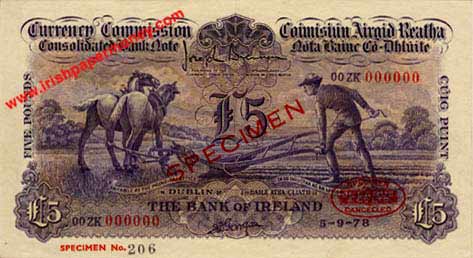
![]()
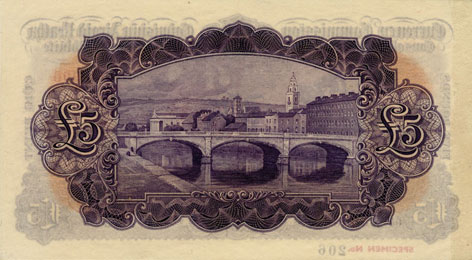
![]()

De La Rue printer's specimens and colour trials of the Ploughman £5 note printed in non-standard colours on non-watermarked paper turn up occasionally
An engraving of St. Patrick's Bridge over the river Lee in Cork city is on the reverse of the Ploughman Five Pound note. The bridge was designed by Sir John Benson (1812-1874) and was completed in 1861 [4.].

St. Patrick's Bridge, over the river Lee, Cork city in 2017. [5. Image copyright Charlesolivercork 2017. Image source: https://commons.wikimedia.org/wiki/File:St.Patrick%27s_Bridge_cork.jpg]
The dimensions of the Consolidated Bank Notes were the same as those of the Legal Tender Notes. The Ploughman Five Pound note measures 151 x 84 mm. This varies by up to 1 or 2 mm in either dimension.
Below are illustrated examples of the first date of a Ploughman Five Pound note, and the last date for which an example had been seen, 22.9.39. The is also the latest date for which the Ploughman 5 Pound notes were printed. Images of every recorded date are on the Ploughman Note Dates page.
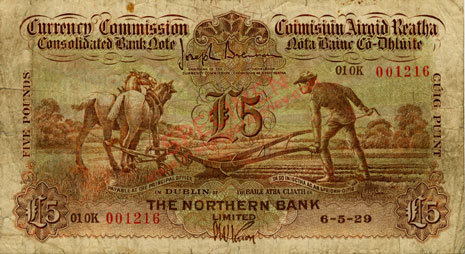
![]()

It is believed that the Ploughman 5 Pound notes were printed in three passes. Initially, a multicolored underprint was printed, leaving a knock-out for the heavier elements of the second print. This was followed by the top printing layer of raised intaglio printing which would have been difficult for would be forgers to effectively reproduce.
The Issuing Authority title text across the top, 'Currency Commission Consolidated Bank Note', 'Coimisiún Airgid Reatha Nóta Bainc Có-Dhlúite' and the main signature 'Joseph Brennan' are printed in raised intaglio print. This print can be easily felt under a finger, even when the note has been well worn.
In addition to the intaglio printing, in the centre of the Five Pound Ploughman notes is a strip of multicolored fibers embedded in the paper which runs down the centre of each note.
The coloured fibre strip was a common security feature of the time which was used on banknotes of some other countries. The fibre strip and the watermarks on the note are visible in the Portals sample paper which is pictured below.
Ploughman Five Pound notes were printed by Thomas De La Rue Ltd on watermarked paper which was manufactured by Portals Limited, a company which specialised in banknote paper.
There are four small watermarks on the Consolidated Five Pound note, one in each corner.
During the design process of the notes, it was considered that a watermark in the centre of a note might be difficult to see under the heavy printing. This resulted in the location of watermarks at the edges of the note, where the can be easily seen from the reverse.
Viewed from the face of the note, the watermarks on the Ploughman Five Pound note are a harp on the left, numeral '£5' on the right, the letters 'CBN' (Consolidated Bank Note) intertwined on the bottom left, and a shamrock on the bottom right. The watermark '£5' on the top right is specific to the Ploughman Five Pound denomination.
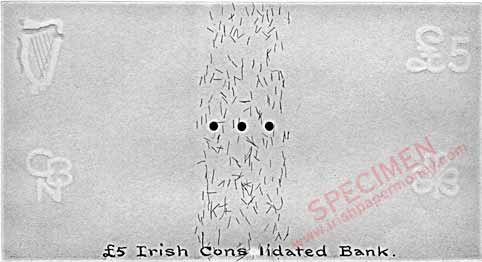
A sample from the manufacturers, Portals, of the watermarked paper for the Ploughman £5 notes shows the positions of the four watermarks on the note
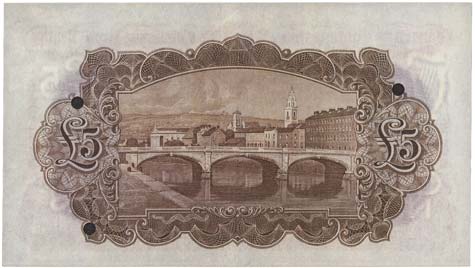
The watermarks on the Five Pound Ploughman note are clearly visible when it is viewed from the reverse side
Currency Commission Consolidated 'Ploughman' Five Pound notes are the second most common denomination of the series after the One Pound notes.
Consolidated Five Pound notes circulated widely throughout Ireland during the Irish Free State era alongside their 'Lady Lavery' Legal Tender counterparts. The Ploughman design 5 Pound notes continued to turn up in occasional circulation up to the 1960s.
All eight banks made widespread usage of the Five Pound Consolidated Bank Notes, and an example of a note of any of the banks is relatively easy to obtain.
Consolidated Five Pound notes issued by the National Bank make up nearly 27% of the total number of £5 Ploughman notes recorded in the Consolidated Bank Note Population Report. The next highest total of recorded notes is for the Hibernian Bank, at 15.8%. Hibernian Bank £5 notes used to be much scarcer, until during 2016-2017 a hoard of Ploughman notes appeared in a Heritage Auctions sale in the US which included a disproportionately large amount of Hibernian £5 notes. This undermined the established value of the note and pushed it from being among the scarcer £5 notes into the centre ground of being relatively common.
The National Bank is the easiest bank for which a high grade Ploughman Five Pound note is available. A sequential run of up to a hundred National Bank £5 notes is possible in the prefix range 03NK 052500-NK03 052600, with many notes in the prefix range being recorded in EF-AU range. These notes turned up in a branch of the Munster and Leinster Bank in the 1970s, and have been seen on the market since then. However, it cannot be assumed that all notes within this range survived, as there are many within the range which have yet to be recorded.
Small numbers of high grade examples, EF or better, of 5 Pound Ploughman notes are also known for the Hibernian, Munster & Leinster, and Provincial Banks. Occasional examples of high grade notes also turn up for other banks.
The Northern Bank and Royal Bank of Ireland are the scarcest banks for the Ploughman Five Pound note.
1929 and 1933 are the commonest years for the Five Pound notes of all the banks, except the Northern, Provincial, and Royal where 1929 is rare. 29.1.31 is a very rare date for two banks, Hibernian and National. This date has a very low printage for each bank [CBIAR]. 22.9.39 is a very rare date for the Munster and Leinster Bank.
Bank of Ireland was the largest issuer of £1 notes, being the only bank to complete the initial prefix A of 01-99 notes, and continuing up to prefix 09BB by 1939.
The highest prefixes recorded for Ploughman £5 notes are for the Munster & Leinster Bank (prefix 04MK on notes dated 22.9.39), and National Bank (prefix 04NK), two of the three most common banks for the Ploughman Five Pound notes. However, Hibernian Bank 5 Pound notes (prefix recorded to 03HK, 15.8% of £5 notes recorded in PSS) are more common than those of the Munster & Leinster Bank (12.4% of £5 notes recorded in PSS), due to the Heritage Auctions hoard.
As with the all Ploughman note denominations, the 5 Pound notes ceased production after the Currency Commission Ireland was wound up in 1942 to be replaced by the Central Bank of Ireland in early 1932. The 5 Pound notes continued to be issued and redeemed by the banks past this point.
All Consolidated note issues ceased on 31 December 1953, after which the Central Bank of Ireland became the sole issuer of banknotes in Ireland.
Ploughman Five Pound notes are common banknotes. A decent example of a note issued by one of the common banks is easily obtained quite inexpensively.
Data from the Consolidated Bank Note Population Report, which is derived the Ploughman Scan Survey (PSS), reveals the relative rarity of Ploughman Five Pound notes among the banks of issue:
National Bank (26.9%), Hibernian Bank (15.8%), Bank of Ireland (14%), Munster & Leinster Bank (12.4%), Provincial Bank of Ireland (11.7%), Ulster Bank (7.2%), Northern Bank (6.3%), Royal Bank of Ireland (5.7%).
Below is illustrated an example of a Ploughman Five Pound note issued by each of the eight banks.

![]()

![]()

![]()
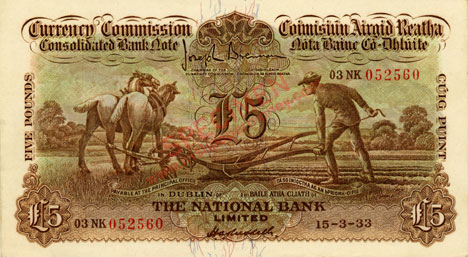
![]()

![]()
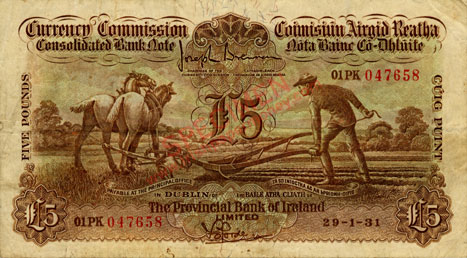
![]()

![]()

There are 17 signature varieties distributed among the eight banks for the £5 Consolidated Bank Note. Of these, two were never issued, and three of the remainder are rare: Northern Bank 5 Pounds with Knox signature, with 14 examples recorded in the Consolidated Bank Note Population Report; Provincial Bank of Ireland 5 Pounds with Robertson signature, 10 examples recorded; and Royal Bank of Ireland 5 Pounds with Stanley signature, 15 examples recorded. All three have one date for the signature, 6 May 1929.
While some are scarce, examples of all of the other 14 signatures are regularly offered and would be relatively easy to obtain.
Bank of Ireland: Gargan 1929-1931, Johnston 1939.
Hibernian Bank: Campbell 1929-1939.
Munster & Leinster Bank: Gubbins 1929-1933, Hosford 1938-1939.
National Bank: Russell 1929-1939.
Northern Bank: Knox 1929, Stewart 1931-1933, (Scott 1939 never issued).
Provincial Bank of Ireland: Robertson 1929, Fforde 1931, Kennedy 1939.
Royal Bank of Ireland: Stanley 1929, Mack 1931, (Wilson 1939 never issued).
Ulster Bank: Patton 1929-1933, Lester 1938-1939.
References [Last retrieved 14.08.24]
1. Central Bank of Ireland Archives.
2. Dermod O'Brien (1865-1945) <https://www.dib.ie/biography/obrien-dermod-a6460p>
3. Joseph Brennan (1887-1976) <https://www.dib.ie/biography/brennan-joseph-a0938>
4. Sir John Benson, architect. <https://www.dib.ie/biography/benson-sir-john-a0586>
5. St. Patrick's Bridge, Cork city in 2017. Image copyright Charlesolivercork 2017. Reproduced under Creative Commons Attribution-Share Alike 4.0 International license. Image source: < https://commons.wikimedia.org/wiki/File:St.Patrick%27s_Bridge_cork.jpg >
1 Pound Ploughman
5 Pounds Ploughman
10 Pounds Ploughman
20 Pounds Ploughman
50 Pounds Ploughman
100 Pounds Ploughman
Irish Ten Shilling Notes
1 Pound Note Lady Lavery
5 Pounds Lady Lavery
10 Pounds Lady Lavery
20 Pounds Lady Lavery
50 Pounds Lady Lavery
100 Pounds Lady Lavery
1 Pound Note, Queen Medb
5 Pound Note, John Scotus Eriugena
10 Pound Note, Jonathan Swift
20 Pound Note, W. B. Yeats
50 Pound Note, Turlough O'Carolan
100 Pound Note, Grace O'Malley
5 Pound Note, Sister Catherine McAuley
10 Pound Note, James Joyce
20 Pound Note, Daniel O'Connell
50 Pound Note, Douglas Hyde
100 Pound Note, Charles Stewart Parnell
Northen Ireland Polymer notes
Bank of Ireland Polymer Notes
Danske Bank Polymer Notes
Ulster Bank Polymer Notes
Special Sections and Articles
The Transition of Irish Currency, Irish banknotes 1918–1928
The Partition of Irish Currency, Irish banknotes 1928–1930
Banknote Design Evolution 1824 to 1916
Irish Three Pound Notes
Contemporary Forgeries of Early Irish Banknotes, ca1800-1930
Limerick Soviet Notes
Irish World War 2 Banknote Issues
Low Number Irish Banknotes
Irish Joint Stock Banks of Note Issue from 1783
Irish Legal Tender Note Specimens
Ploughman Scan Survey (PSS)
![]() Stable version. Last update 24.08.24.
Stable version. Last update 24.08.24.